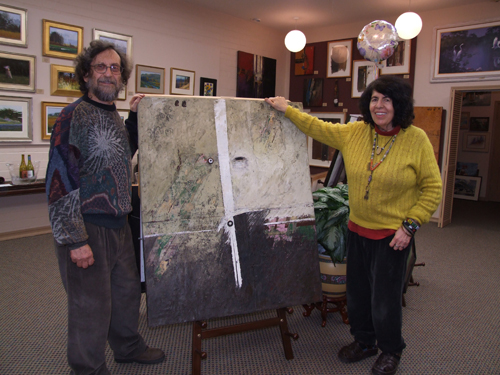
By Donald H. Harrison

LA MESA, California — For those who try to link Israel to the old apartheid regime of South Africa, artist Atara-Baker, who has lived in both countries, offers an emotional rejoinder, not in her words, but in her art.
Yes, the art seems to say, there is a link between Israel and Southern Africa, but it is not with the now defunct apartheid regime; rather it is with Southern Africa’s indigenous peoples who, like Judeans of long ago, dwelled in desert caves and stored their treasures there.
In her “African Masks” exhibit, now on display at O’Dunn Fine Art, at 8325 La Mesa Blvd, the modern artist in some works combines the colors and textures of the masks and cave paintings of the San people of the Kalihari Desert of Botswana and Namibia (formerly South-West Africa) with reminders of the Qumram Caves, in the Judean Desert, where the Dead Sea Scrolls were found.
Born in Israel, where she said her Polish immigrant father used to attract crowds making sand art on the beaches of Tel Aviv, and trained in the art schools of Rome, Italy, and Johannesburg, South Africa, Atara Epshtein Baker has been living in San Diego County for 29 years along with her architect husband, Louis Baker.
Here she was influenced by the late artist and print maker Gary Hansmann, “who taught me to bring something from myself, something from my childhood, so I started to try to combine the African masks and my Jewish background. I took the African masks, together with the material of the African masks, the scenery of the desert, the landscape, the feeling, the air, and I tried to develop a new way to express myself.”
Her works aren’t two-dimensional masks, but are impressionistic paintings, collages and assemblages, evoking what Atara-Baker refers to as her “primeval self.” Typically, there are representations of eyes, which are central features of any mask, and various textures, especially cheese cloth, which she said is a common material used by tribal artists.
While living and studying in Johannesburg, she began collecting African masks, and the more she looked at the materials from which they were made, the more she was reminded of Qumram, where in the 1st Century of the common era, Israelite people hid their sacred writings from the Romans who had laid waste to the Temple in Jerusalem and later laid siege to the nearby fortress mountain of Masada.
“The stripes that they (the San) use in the mask remind me of a tallit, and I use the five colors that they use–mostly earth-tone colors,” Baker said during a March 15 reception at the gallery in downtown La Mesa. The San place their fingertips on the painting, making this method of identification part of the design, and Baker has incorporated the practice into her art. There also are Hebrew words appearing in some of her layered paintings, faded as they might be on the walls of a cave.
“The Bushmen (San) lived in caves and painted animals — giraffes or buffalos,” she said. “Instead of animals, I use all kinds of images, I try to make it in the language of painting.”
In her assemblages, she takes pieces of wood, perhaps staves from a whiskey barrel, and burns them on the stove, then makes holes, and nails the wood. Then she will wrap the wood, another reference to the Dead Sea Scrolls. In her collages, she uses newspapers, not necessarily for their words, but for their textures, using masking tape to protect them from stain or wear from other techniques.
Appreciative of all those who have contributed to her development as an artist, she tells of Bill Ainslee, who had a private art school in Johannesburg, and taught her to “be truthful to your emotion, bring your feeling into the painting.” And she credits her architect husband Louis, with contributing to her appreciation for the line and balance of a painting.
Shannon O’Dunn, proprietor of the gallery which shows a wide variety of art, says she anticipates a long continuing relationship between the gallery and the artist.
*
Harrison is editor of San Diego Jewish World. He may be contacted at donald.harrison@sdjewishworld.com